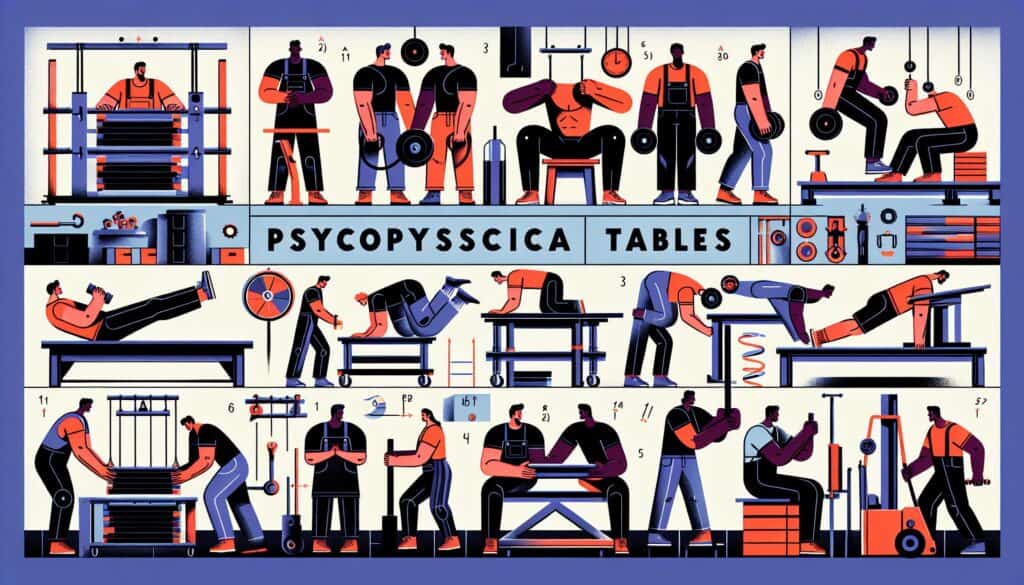Tables that provide design goals for manual material handling tasks (lifting, lowering, pushing, pulling, carrying) based on what percentage of the industrial population can perform them without overexertion.
- Méthodologies : Lean Sigma, Fabrication, Résolution de problèmes, Qualité
Psychophysical Tables (Snook Tables)

Psychophysical Tables (Snook Tables)
- Amélioration continue, Conception pour la fabrication (DfM), Conception pour la durabilité, Ergonomie, Facteurs humains, Conception centrée sur l'humain, Amélioration des processus, Gestion des risques, Safety
Objectif :
Comment il est utilisé :
- Based on extensive research where subjects adjusted task variables (e.g., weight, distance, frequency) to their maximum acceptable level. The tables present these acceptable limits for different percentages of male and female populations.
Avantages
- Provide data-driven guidelines for designing manual handling tasks; helps reduce the risk of overexertion injuries; considers both male and female populations.
Inconvénients
- Data is based on specific laboratory conditions and may not perfectly translate to all work environments; tables can be complex to interpret and apply correctly; focuses on specific types of tasks.
Catégories :
- Ergonomie
Idéal pour :
- Determining acceptable weights, forces, and frequencies for manual material handling tasks to accommodate a certain percentage of the workforce.
The methodology of Psychophysical Tables (Snook Tables) provides a valuable resource in industries where manual material handling is prevalent, such as manufacturing, logistics, healthcare, and construction. This approach supports the assessment of ergonomic risks associated with various tasks by identifying weight limits and force tolerances based on empirical data collected from diverse demographic groups, thus allowing for the optimization of work environments and procedures. Employers in these sectors can utilize the tables during the design phase of equipment and workflows, ensuring that physical demands align with the capabilities of the workforce. In practice, ergonomics specialists and safety engineers often initiate studies using Snook Tables to guide interventions aimed at improving occupational safety and efficiency. The methodology also encourages collaboration among project managers, HR personnel, and ergonomists to foster a more inclusive workplace that accommodates the physical strengths of all employees. By applying findings from psychophysical research, organizations can create systems that reduce worker fatigue, lower incidence rates of musculoskeletal disorders, and enhance overall productivity while maintaining compliance with regulatory standards concerning worker health and safety. The data helps in the gradual implementation of engineered solutions, training programs, and ergonomic assessments, benefiting not only company policies but also the wellbeing and satisfaction of the workforce.
Principales étapes de cette méthodologie
- Identify the target population and their demographic characteristics (e.g., age, gender, physical capability).
- Conduct experimental tasks where subjects adjust variables (e.g., weight, height, frequency) to their maximum acceptable level.
- Compile collected data to establish acceptable limits for specific task variables across different population segments.
- Use statistical analysis to identify trends and develop guidelines for acceptable weight, force, and frequency thresholds.
- Create psychophysical tables that summarize acceptable limits for various tasks tailored to male and female thresholds.
- Apply the psychophysical tables during the design phase of manual handling tasks.
- Iterate and refine task designs based on feedback and ongoing observations in practical settings.
Conseils de pro
- Utilize Snook Tables to establish benchmarks based on percentile data, ensuring tasks meet the capabilities of the target population.
- Incorporate variability in task design by including adjustments for factors such as grip type and posture, as suggested by the latest ergonomic research.
- Continuously validate and update psychophysical data with real-world testing to account for evolving workforce demographics and capabilities.
Lire et comparer plusieurs méthodologies, nous recommandons le
> Référentiel méthodologique étendu <
ainsi que plus de 400 autres méthodologies.
Vos commentaires sur cette méthodologie ou des informations supplémentaires sont les bienvenus sur le site web de la Commission européenne. section des commentaires ci-dessous ↓ , ainsi que toute idée ou lien en rapport avec l'ingénierie.
Contexte historique
1986
(si la date est inconnue ou non pertinente, par exemple « mécanique des fluides », une estimation arrondie de son émergence notable est fournie)

Articles Similaires
Gestion des opérations de fabrication (MOM)
Système d'exécution de la fabrication (MES)
Plan de contrôle de la fabrication
Tests manuels
Tableaux d'évaluation des manutentions manuelles (MAC)
ManTRA (outil d'évaluation des risques liés aux tâches manuelles)